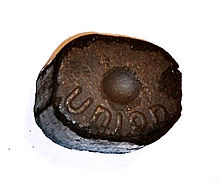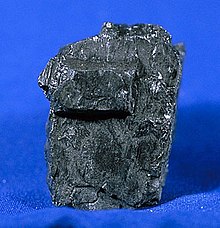Coal refinement
The coal upgrading makes coal a variety of useful secondary products. Partly z. B. the lignite through the refinement even usable. Since the beginning of industrialization, coal refining has always adapted to the changing needs of the market with the expansion of chemical and engineering knowledge.
Types of coal refinement

Coking
The earliest coal refinement is coking in coking plants or, if the focus is more on gas generation, coal gasification in gas works . Due to its content of volatile and sulphurous components, raw coal is not or less suitable for some combustion processes - such as smelting . The first coke from hard coal was produced in England in 1713 and in Germany in 1796 in the industrial area of Upper Silesia . The coke oven gas made at the beginning of the 19th century gas lighting in the urban lights the streets bright and fired later cookers. Today it is only used industrially. Lignite is now also refined into coke and used in certain grain sizes as activated carbon, for example in filter and sewage treatment plants.
liquefaction
The coal liquefaction was mainly in the Second World War, important as a substitute for crude oil. The Fischer-Tropsch synthesis was developed in 1925 at what is now the Max Planck Institute for Coal Research in Mülheim an der Ruhr . The coal liquefaction process was later used by the Sasol company , especially during apartheid in South Africa , to meet the country's fuel needs despite the trade boycott. Although this no longer exists since the end of apartheid, the process can continue to be used economically because it has been further developed and the facilities could reach immense dimensions. With the up-and-coming People's Republic of China , a country is now interested in this process, which has to cover a rapidly growing energy market, but does not have crude oil reserves, whereas coal is available in large quantities.
Research into carbon hydrogenation and coal conversion to synthesis gas is carried out.
Briquette production
The dust from coal extraction was pressed into briquettes with around 7 to 9% coal tar as a binding agent . The popular egg briquettes were important for house firing .
Lignite was originally only pressed by hand into wooden molds and dried in the air into molds called in the Rhenish Klütten in order to reduce the high water content of up to 55%. The first briquette factories were built in the middle of the 19th century in the central German lignite mining area around Halle (Saale) . A little later, industrial lignite mining and processing began in Brühl (Rhineland) .
In the case of lignite briquetting, pressing in an extrusion press after previous grinding in wet service and drying in tubular dryers operated with superheated steam and subsequent cooling is sufficient to avoid spontaneous combustion . The process steam required for this is generated in connected power plants with combined heat and power , which are fired with the coarser parts of the lignite (stumps, less well carbonized tree stumps ) but also with added sewage sludge and waste wood. Unused electricity is fed into the power grid . Process steam and waste heat can also continue to be used. The most modern and efficient refining company belongs to Vattenfall Europe Mining AG and is located in the Lusatian lignite district on the border between Brandenburg and Saxony. In the briquette factory Schwarze Pump , two different whole stones are produced, as well as a half stone and an industrial stone briquette of the quality brand "Lausitzer REKORD" (see record briquette ). The largest producer of lignite briquettes is RWE Power , which markets its briquettes as 3- or 6-inch under the brand name Union-Brikett throughout Europe. Briquettes for domestic and industrial use are only pressed by RWE Power in the Frechen coal refining plant . The latest product since 2006, the Ireland Briquette , is mixed with 30% hard coal dust. Compared to normal lignite briquettes, it releases less sulfur and smoke and is therefore suitable for the Irish areas where soft coal is prohibited (bituminous coal ban, since 1990). This allows the Irish to keep their traditional coal-fired heating systems in the city centers. One hopes for an annual production of 100,000 tons. In 2003, Rheinische Fuel GmbH in Cologne, a 100% subsidiary of RWE Power, sold around half a million tons of briquettes (from both areas). As it is almost no longer are the traditional coal merchant, the briquettes are bundled as house or chimney fire in hardware stores or through Raiffeisen - cooperatives sold.
Other hard coal processing
Anthracite - fine coal with 75% <0.060 mm was a product of the former Niederberg colliery in Neukirchen-Vluyn . It was marketed under the brand name "Carborate". The product (not to be confused with the chemical compound carborate despite the identical name) had properties that were fundamentally different from other grain classes. It was used both as fuel and as a raw material for the chemical industry. Carborate was used as a filler in various plastics, such as the housings of car batteries. Carbofol or NB foil, which was sometimes laid in huge dimensions as roof, pond, or landfill and street foil, got its properties from carborate as a filler. Carborate was also used as a supplement for car tires and as filter carbon for drinking water treatment . Like oil, it could be transported in tank trucks and conveyed through pipes and hoses with conveying air. This made anthracite coal about as convenient and inexpensive to handle as heating oil. The product obtained this property by grinding it into the finest grains in the range of thousandths of a millimeter. Due to the almost complete absence of water of <1%, there were no adhesive bridges between the microscopically fine grains and the product became flowable.
Other lignite refinement
After drying, most of the raw lignite is ground to lignite dust and fluidized bed coal, which are blown into the boiler in large industrial firing systems with an open grate and burned. The particularly effective and therefore relatively environmentally friendly circular fluidized bed process uses a certain grain size of coal. RWE Power has three plants for coal refining. The coal refining company Ville / Berrenrath in the industrial area of Hürth-Knapsack only produces pulverized lignite. The coal refining company Fortuna-Nord in Niederaussem in the city of Bergheim also produces a third of lignite coke.
For brown coal coke, see coking above.
Electricity generation
Ultimately, the use of coal in coal-fired power plants , which generate electricity from coal , can also be called refinement.
information
The RWE Power Information Center for Brown Coal in Paffendorf Castle in Bergheim and the thematic road of Energy, which begins there, provide information about lignite extraction and processing in the Rhenish lignite district .
Web links
- RWE Power lignite factories
- Information on the coking process (Thyssen coking work group)
- Vattenfall's Lusatian refining site
Individual evidence
- ^ Department of the Environment, Community and Local Government: 'Smoky' Coal Ban ( Memento July 1, 2015 in the Internet Archive ).
- ↑ [1] History of the Niederberg coal mine, day-to-day operation
- ↑ [2] CARBOFOL® plastic sealing membrane

